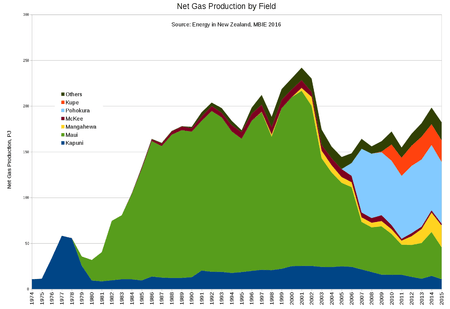Oil and gas industry in New Zealand

The oil and gas industry in New Zealand explores and develops oil and gas fields, and produces petroleum products and natural gas.
In 2015, New Zealand's self-sufficiency in oil (mmbls production divided by consumption) was 30%, i.e. the country imports over two thirds its petroleum product needs (though actual imports are higher, as some of the local product is also exported).[1] In 2015, 97 petajoules of crude were produced in New Zealand, 242 PJ of petroleum products imported (most of it crude), and 261 PJ consumed. The difference is exported or used for international travel (aviation fuel and similar).[1]
Oil and gas are produced from 21 petroleum licenses / permits, all in the Taranaki basin.[2] The most important fields are Kapuni, Maui, Pohokura and Kupe. Exploration for oil and gas reserves includes the Great South Basin and offshore areas near Canterbury and Gisborne.
New Zealand has one oil refinery, the Marsden Point Oil Refinery. The major industry body is the Petroleum Exploration and Production Association of New Zealand.
There are 2,600 kilometres of high-pressure natural gas transmission pipelines in the North Island.[3] Most of these are owned and operated by First Gas, including the Maui pipeline, a 307 km pipeline that carries 78% of all natural gas produced in New Zealand.[4] The low-pressure gas pipelines that distribute gas to end users are owned by First Gas (Northland, Waikato, Bay of Plenty, Gisborne, Kapiti Coast), Vector (Auckland), Powerco (Hawke's Bay, Taranaki, Manawatu, Wellington) and GasNet (Wanganui).
The largest retailers of gas are Contact Energy and Vector.[5] There is no natural gas transmission in the South Island.[6] New Zealand has one underground gas storage facility, the Ahuroa Gas Storage Facility.
History
In 1865, the Alpha well was drilled near Mikotahi at New Plymouth.[7] This was the first oil well in what is now the Commonwealth and one of the first in the world. A petroleum industry developed at Moturoa, including producing wells and refineries. The last refinery there was closed in 1972. The field continues to produce small quantities of oil.[8]
The Kapuni gas field in South Taranaki was discovered in 1959 and brought into production in 1970. The off-shore Maui field was discovered in 1969 and brought into production in 1978. This supported the development of many large energy projects, including gas fired power stations at New Plymouth and Huntly, ammonia-urea plant at Kapuni, gas to methanol plant at Waitara and the synthetic petrol plant at Motunui.[9]
Oil and gas fields

Proven and probable (P50) reserves, ultimate and remaining, as at 1 January 2016[1]
Producing fields
| Field | Ultimate oil recoverable (mmbbls) |
Remaining oil reserves (mmbbls) |
Ultimate gas recoverable (PJ) |
Remaining gas reserves (PJ) |
|---|---|---|---|---|
| Kapuni | 67 | 1 | 1,040 | 36 |
| Kupe | 18 | 8 | 391 | 2442 |
| Maari | 45 | 15 | ||
| Mangahewa | 12 | 8 | 457 | 317 |
| Maui | 225 | 6 | 4,309 | 191 |
| McKee | 49 | 2 | 235 | 36 |
| Pohokura | 64 | 26 | 1,524 | 875 |
| Tui | 42 | 3 | ||
| Turangi | 14 | 11 | 381 | 315 |
| Others | 53 | 11 | 410 | 104 |
| Total | 588 | 91 | 8,748 | 2,116 |
See also
- Energy in New Zealand
- Oil and gas companies in New Zealand
References
- 1 2 3 "Energy in New Zealand 2016". MBIE. September 2016.
- ↑ "Petroleum Overview". Crown Minerals, Ministry of Economic Development. 26 June 2008.
- ↑ Gregg, Roger; Walrond, Carl (13 July 2012). "Oil and gas – The Māui gas field". Te Ara – the Encyclopedia of New Zealand. Retrieved 28 November 2015.
- ↑ "Completion of Vector Gas Ltd Purchase by First State Funds" (Press release). Firstgas. 20 April 2016.
- ↑ "New Zealand gas industry". Contact Energy. Retrieved 28 November 2015.
- ↑ "Gas distribution". Contact Energy. Retrieved 28 November 2015.
- ↑ Lambert, Ron (1995). In Crude State - a History of the Moturoa Oilfield New Plymouth. Methanex New Zealand. ISBN 0-473-03428-X.
- ↑ "Moturoa black gold - "the good oil"". Puke Ariki. 19 November 2004. Retrieved 2009-07-25.
- ↑ "History of New Zealand's gas sector". MBIE. 8 January 2016.